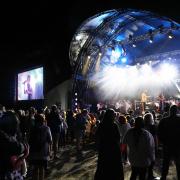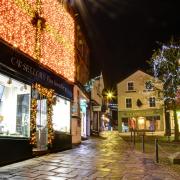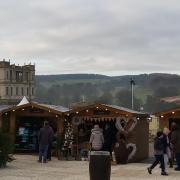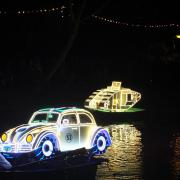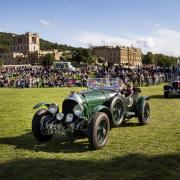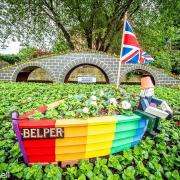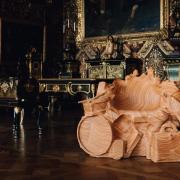In its bicentenary year Derbyshire Life casts a Derbyshire eye over the historic encounter between Britain and France

Sunday 18th June 1815 – on sodden fields close to Brussels the Battle of Waterloo was fought. The principal protagonists Britain and France were commanded by Arthur Wellesley (1769-1852) – later 1st Duke of Wellington – and Napoleon Bonaparte (1769-1821). It was ‘the day that decided Europe’s fate’
Since being declared French Emperor in 1804 Napoleon had dominated Europe under his military dictatorship. Britain and other threatened nations – Russia, Prussia and Austria – determined to stop him. The Napoleonic Wars marked the years of ensuing conflict.
By 1814 it seemed the Allies had prevailed. Napoleon abdicated the French throne and in April 1814 was banished by the Allies to the island of Elba off Italy. But in February 1815 Napoleon escaped Elba and returned to Paris with renewed support.
He invaded Belgium hoping to capture Brussels. Enough was enough – Britain and her Allies formally declared war on France – the stage was set for one decisive confrontation near the town of Waterloo. There 68,000 Allied troops – many inexperienced – faced 72,000 of Napoleon’s, many his trusted ‘old guard’.

Allied victory ended over 20 years of conflict – European peace was assured for an extended period, the First French Empire ended, and Napoleon exiled to the remote South Atlantic island of St Helena where he died in 1821 aged 52. By contrast the ‘Iron Duke’ became British Prime Minister (1828-30) and died aged 83 in 1852. Yet both ‘victor’ and ‘vanquished’ became enduring cult figures.
Waterloo may be remote from Derbyshire – yet fascinating links endure. Most poignant are the county’s Waterloo Veterans – many bore that honour with pride and several loom large in the annals.
A headstone in St Michael’s churchyard Holbrook reads: ‘In loving memory of Rev. William Leeke MA, for 37 years the beloved incumbent of this parish. He carried the regimental colours of the 52nd Light Infantry at the Battle of Waterloo June 18th 1815. He entered into rest June 6th 1879 aged 81 years – a good soldier of Christ.’
Born in the Isle of Wight, Leeke married a Derby girl and became curate of Brailsford in 1831. He was curate of Holbrook from 1840 to 1879, and from 1849 Rural Dean of Duffield. Residing at Holbrook Hall, his tranquil clerical life belied the harrowing experiences of his soldier youth.

Aged 17 he was the youngest officer at Waterloo, later cementing that celebrity by publishing his reminiscences. Leeke’s work formed the primary source for many modern accounts of the battle – it also proved controversial, some historians questioning his version of events.
Of different rank was Private Samuel Godley (1778-1832) of the Second Regiment of Life Guards. Born in Whitwell – son of a shoemaker – a cameo act of courage witnessed by admiring colleagues made him a Waterloo legend.
When his horse was shot from under him, he wrested a replacement from a mounted French Cuirassier despite suffering a fractured skull in the struggle – then continued in battle the rest of the day. A silver plate on his repaired bald pate distinguished him for life. The ‘Whitwell Warrior’ died in London, his St John’s Wood grave bearing a long inscription of the Derbyshire man’s heroics.
A local trio is completed ‘across the border’ in Burton-on-Trent. With its Waterloo Street and Wellington Street are the less transparent Uxbridge Street and Anglesey Road – they honour the Burton credentials of Wellington’s cavalry commander at Waterloo.

He was Field Marshall Henry William Paget (1768-1854) – 1st Marquess of Anglesey and Earl of Uxbridge – whose family owned much of Burton for centuries. Paget’s family seat was at Rugeley and he is buried in Lichfield Cathedral where a statue is raised in his honour.
At Waterloo he led a pivotal cavalry charge – famously losing part of a leg, necessitating amputation. He and Wellington were no great friends – witness the alleged exchange when Uxbridge was stricken. He exclaimed to Wellington looking on: ‘By God, sir, I’ve lost my leg.’ To which the ‘Iron Duke’ casually replied: ‘By God, sir, so you have.’
Apocryphal or not, it is part of the rich tapestry of Waterloo – indeed such was the fervour surrounding Britain’s victory that communities were quick to claim any shred of credit for the defeat of France and its ‘Little Emperor’.
Hence the historic Cannon Mill in Chesterfield – originally Griffin Foundry – which claims to have made cannonballs for use at Waterloo. Balls were also said to have been stored in warehouses at Shardlow before being shipped to Wellington’s army. Romantic associations – but it’s possible the ammunition never left Britain, instead being held in ports to protect against any invasion by a French fleet.
That perceived threat is significant, because until Napoleon was properly defeated there was a genuine fear that Britain could suffer a French invasion. Even ‘landlocked’ Derbyshire took precautions – a newspaper stating ‘the people of Derbyshire flocked to the colours in their thousands to resist the foreign invader.’
By 1804 the county’s ‘home guard’ numbered 6,594 men in 59 volunteer corps, later superceded by five regiments of Volunteer Militia formed at Derby, Belper, Chatsworth, Scarsdale and Wirksworth. These stout defenders served in tandem with their day jobs until Napoleon was safely exiled in St Helena. Shades of ‘Dad’s Army’ perhaps – but a French-occupied Derbyshire was simply unthinkable – ‘Bonjour mon canard’ just wouldn’t have worked. Only after 18th June 1815 could Britain celebrate lasting victory – although Derby exercised caution before unfurling the bunting. This because the town’s leaders had earlier jumped the gun by staging lavish ‘Victory’ celebrations in spring 1814 when Napoleon was exiled to Elba. Thousands were spent decorating the town – the County Hall illuminated by a myriad of naked candles (which blew out in the wind) and Joseph Strutt’s house writ large with the word ‘PEACE’. Alas Napoleon begged to differ...
So when victory did arrive Derby hesitated – partly out of necessity, for long-distance communication was then measured in weeks rather than seconds. Not until 29th June did the Derby Mercury print dispatches from Waterloo – and the report was inconclusive. Only on 8th July 1815 did the townsfolk fully believe – when the Traveller Coach led by eight greys arrived bedecked with laurels and white lilies, trailing a French flag behind it. Traversing Derby Market Place it halted at the New Inn coaching house in King Street where ‘in front of a huge crowd the French flag was enthusiastically burned.’
Other symbols of victory were less immediate. Derbyshire’s landmark Wellington Cross on Baslow Edge was not erected until 1866 – raised by E.M. Wrench ‘late of the 34th Regiment’. Countless saplings were planted to mark victory – the ‘Waterloo Clump’ at Winshill near Burton a good matured example, the Wellington Oak at Renishaw Hall another. The Derby Porcelain Company produced figures of both Wellington and Napoleon – and after Wellington’s death in 1852 Jobson’s Iron Foundry in Derby produced the definitive limited edition plaque to mourn a national hero.
Public Houses were suitably re-named – Derby had a ‘Duke of Wellington’, ‘Marquess of Anglesey’, and ‘Waterloo Tavern’ – but also a ‘Napoleon Inn’ in Parker Street. It survived until 1963 – demolished by developers not Francophobes.
Therein is a quirk of Waterloo – Napoleon exercised a fascination even for Britons... indeed some revered the former Emperor for his statesmanship and sheer charisma. British travellers sought audiences with Napoleon in St Helena – the Sixth Duke of Devonshire (1790-1858) was a particular admirer, amassing at Chatsworth House a fine array of Napoleonic ‘memorabilia’.
In his purpose-built Sculpture Gallery the ‘Bachelor Duke’ displayed a colossal marble bust of Napoleon alongside exquisite statues of the Emperor’s mother Letizia and his sister Paolina – indeed it was rumoured that the Anglo-French alliance between the Sixth Duke and the beautiful Paolina was an intimate one. The Napoleon statuary can still be admired at Chatsworth today.
Derbyshire’s links with Waterloo and the Napoleonic Campaigns do not end there. Between 1803 and 1814 some 172 French prisoners of war were billeted at Ashbourne – it was even said that a French PoW ‘invented’ Ashbourne’s singular brand of gingerbread. Several local girls married Frenchmen. There are PoW graves in the town’s churchyards, and a ‘Napoleon House’...
In the car park of Derby’s Territorial Army HQ on Sinfin Lane is a glorious weeping willow. Known as Napoleon’s Willow it was grown from a cutting taken from a tree which once stood at Normanton Barracks – the now-demolished former Regimental Depot of the Sherwood Foresters. That tree in turn descended from a cutting of Napoleon’s favourite shady willow on St Helena – originally brought to England by the 45th Regiment of Foot (Sherwood Foresters) who had been guarding Napoleon in exile.
Fancy – a spiritual link to the great adversary in a Sinfin car park! Many more Waterloo connections exist in Derbyshire – personalities, graves, churches, public houses, plaques, artworks, militaria. Two hundred years have passed, but distant echoes of 18th June 1815 are all around us, the intriguing legacies of a victory that Britons once genuinely rejoiced in – good reason for the Battle of Waterloo to be commemorated now.
‘Wellington – Triumphs, Politics and Passions’
For anyone planning a visit to London, until 7th June the National Portrait Gallery is showing ‘Wellington – Triumphs, Politics and Passions’, English Heritage opens Wellington’s London home, Apsley House, 149 Piccadilly, Hyde Park Corner, London, W1J 7NT, Wed-Sun from 11am-5pm, where the grand Waterloo Banquet, an annual dinner held to celebrate the defeat of Napoleon, has been recreated. Apsley House also contains fine paintings, sculptures, works of art and gifts from emperors, tsars and kings to the Iron Duke. English Heritage also opens The Wellington Arch at Hyde Park corner and has created an excellent exhibition which includes a spoken commentary of the Battle. See also www.nam.ac.uk/waterloo200






